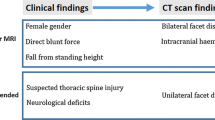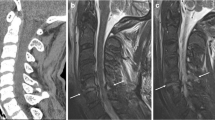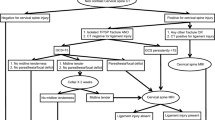Abstract
The purpose of the study was to determine the role of magnetic resonance imaging (MRI) in intubated multitrauma patients with normal computed tomography (CT) in excluding unstable ligamentous injury to the cervical spine. A retrospective evaluation was done on those multitrauma patients admitted to the intensive care unit of a level 1 trauma centre who had normal single-slice helical CT cervical spine and underwent MRI for cervical spine clearance from 1/1/04 to 30/6/05. Fifty-five patients met the inclusion criteria. Ten of these patients had a discoligamentous injury identified on MRI; however, all these patients had injuries limited to only one of the three columns of the cervical spine. Single-slice helical CT with sagittal reformats had a negative predictive value of 82% for discoligamentous injury and 100% for unstable injury. A normal single-slice helical CT with sagittal reformats of the cervical spine in intubated trauma patients excluded unstable injuries at follow-up cervical spine MR imaging.
Similar content being viewed by others
References
Berne J, Velmahos G, El-Tawil Q et al (1999) Value of complete cervical helical computed tomographic scanning in identifying cervical spine injury in the not evaluable blunt trauma with multiple injuries: a prospective study. J Trauma 47:896–902, doi:10.1097/00005373-199911000-00014
Pasquale M (1998) Practice management guidelines for trauma: EAST adhoc committee on guideline development—identifying cervical spine instability after trauma. J Trauma 44:945–946, doi:10.1097/00005373-199806000-00001
Ravichandran G, Silver J (1982) Missed injuries of the spinal cord. BMJ 284:953–956
Cooper DJ, Ackland HM (2005) Clearing the cervical spine in unconscious head injured patients—the evidence. Crit Care Resusc 7:181–184
Sanchez B, Waxman K, Jones T et al (2005) Cervical spine clearance in blunt trauma: evaluation of a computed tomography-based protocol. J Trauma 59:179–183, doi:10.1097/01.TA.0000171449.94650.81
Padayachee L, Cooper D, Irons S et al (2006) Cervical spine clearance in unconscious traumatic brain injury patients: dynamic flexion-extension fluoroscopy versus computed tomography with three-dimensional reconstruction. J Trauma 60:341–345, doi:10.1097/01.ta.0000195716.73126.12
Hogan G, Mirvis S, Shanmuganathan K et al (2005) Exclusion of unstable cervical spine injury in obtunded patients with blunt trauma: is MR imaging needed when multi-detector row CT findings are normal? Radiology 237:106–113, doi:10.1148/radiol.2371040697
Brohi K, Healy M, Fotheringham T et al (2005) Helical computed tomographic scanning for the evaluation of the cervical spine in the unconscious, intubated trauma patient. J Trauma 58:897–901, doi:10.1097/01.TA.0000171984.25699.35
Denis F (1984) Spinal instability as defined by the three column spine concept in acute spinal trauma. Clin Orthop Relat Res 189:65–76
Ackland HM, Cooper DJ, Malham GM, Kossmann T (2007) Factor predicting cervical collar related decubitus ulceration in major trauma patients. Spine 32:423–428, doi:10.1097/01.brs.0000255096.52871.4e
Como JJ, Marsha A, Thompson RN et al (2007) Is magnetic resonance imaging essential in clearing the cervical spine in obtunded patients with blunt trauma. J Trauma 63:544–549, doi:10.1097/TA.0b013e31812e51ae
Acknowledgement
We thank Dr Helen Kavnoudias and Nicola Gollogly for their assistance.
Author information
Authors and Affiliations
Corresponding author
Rights and permissions
About this article
Cite this article
Schoenwaelder, M., Maclaurin, W. & Varma, D. Assessing potential spinal injury in the intubated multitrauma patient: does MRI add value?. Emerg Radiol 16, 129–132 (2009). https://doi.org/10.1007/s10140-008-0749-7
Received:
Accepted:
Published:
Issue Date:
DOI: https://doi.org/10.1007/s10140-008-0749-7




